BO1COAC318 Corporate Accounting: Acquisition Method Report
VerifiedAdded on 2022/10/11
|9
|1934
|18
Report
AI Summary
This report delves into the intricacies of corporate accounting, with a primary focus on the acquisition method and business combinations. It meticulously outlines the requirements of the acquisition method, including acquirer identification, recognition and measurement of assets and liabilities, determination of the acquisition date, and the calculation of goodwill. The report references AASB 3 and other relevant accounting standards, providing a detailed explanation of the principles and procedures involved. It also presents a practical application of these concepts through a case study involving Davis Ltd, demonstrating the application of accounting standards in a real-world scenario. The report further includes worksheet entries and financial data to illustrate the accounting treatments for business combinations, providing a comprehensive understanding of the subject matter.
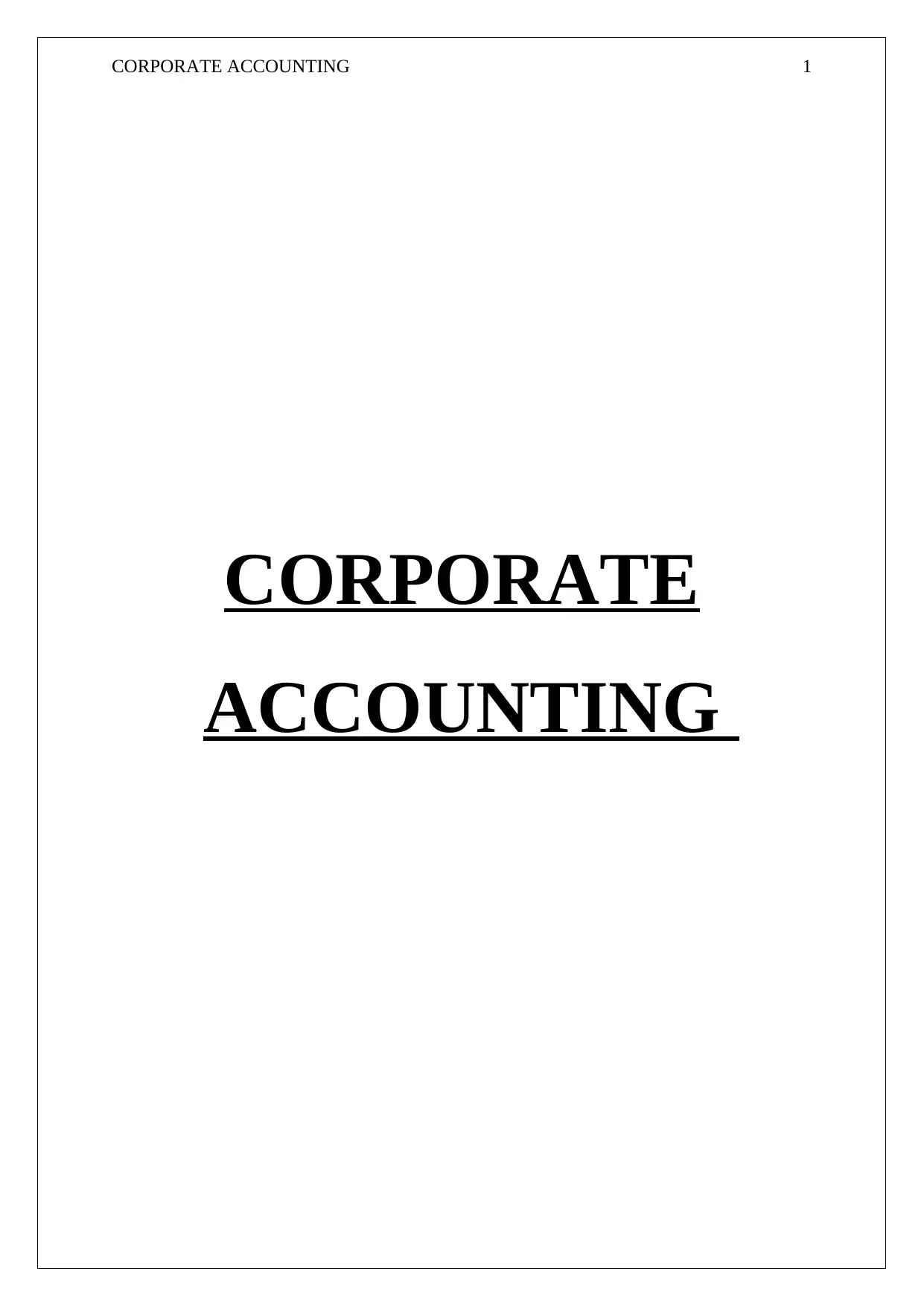
CORPORATE ACCOUNTING 1
CORPORATE
ACCOUNTING
CORPORATE
ACCOUNTING
Secure Best Marks with AI Grader
Need help grading? Try our AI Grader for instant feedback on your assignments.
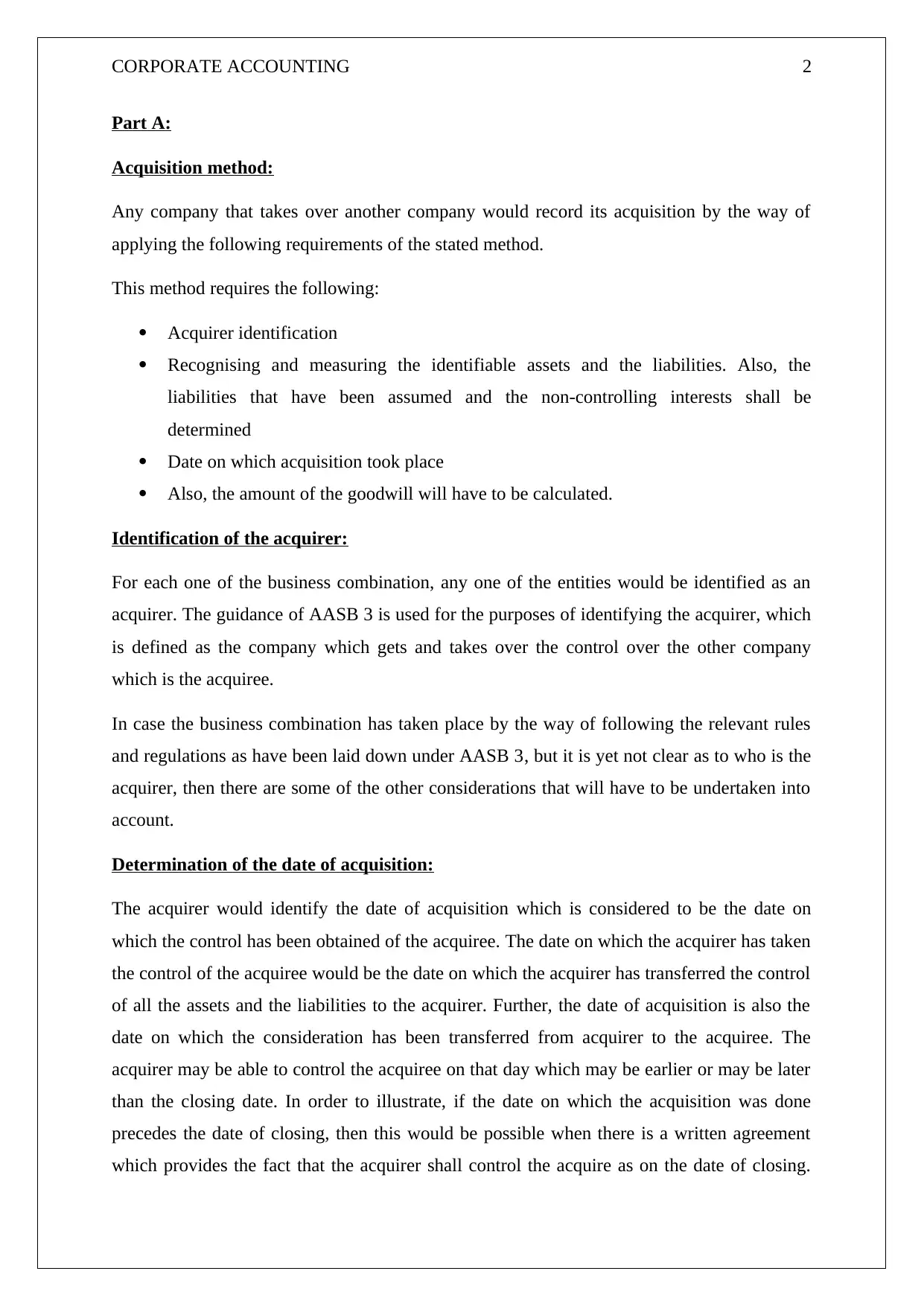
CORPORATE ACCOUNTING 2
Part A:
Acquisition method:
Any company that takes over another company would record its acquisition by the way of
applying the following requirements of the stated method.
This method requires the following:
Acquirer identification
Recognising and measuring the identifiable assets and the liabilities. Also, the
liabilities that have been assumed and the non-controlling interests shall be
determined
Date on which acquisition took place
Also, the amount of the goodwill will have to be calculated.
Identification of the acquirer:
For each one of the business combination, any one of the entities would be identified as an
acquirer. The guidance of AASB 3 is used for the purposes of identifying the acquirer, which
is defined as the company which gets and takes over the control over the other company
which is the acquiree.
In case the business combination has taken place by the way of following the relevant rules
and regulations as have been laid down under AASB 3, but it is yet not clear as to who is the
acquirer, then there are some of the other considerations that will have to be undertaken into
account.
Determination of the date of acquisition:
The acquirer would identify the date of acquisition which is considered to be the date on
which the control has been obtained of the acquiree. The date on which the acquirer has taken
the control of the acquiree would be the date on which the acquirer has transferred the control
of all the assets and the liabilities to the acquirer. Further, the date of acquisition is also the
date on which the consideration has been transferred from acquirer to the acquiree. The
acquirer may be able to control the acquiree on that day which may be earlier or may be later
than the closing date. In order to illustrate, if the date on which the acquisition was done
precedes the date of closing, then this would be possible when there is a written agreement
which provides the fact that the acquirer shall control the acquire as on the date of closing.
Part A:
Acquisition method:
Any company that takes over another company would record its acquisition by the way of
applying the following requirements of the stated method.
This method requires the following:
Acquirer identification
Recognising and measuring the identifiable assets and the liabilities. Also, the
liabilities that have been assumed and the non-controlling interests shall be
determined
Date on which acquisition took place
Also, the amount of the goodwill will have to be calculated.
Identification of the acquirer:
For each one of the business combination, any one of the entities would be identified as an
acquirer. The guidance of AASB 3 is used for the purposes of identifying the acquirer, which
is defined as the company which gets and takes over the control over the other company
which is the acquiree.
In case the business combination has taken place by the way of following the relevant rules
and regulations as have been laid down under AASB 3, but it is yet not clear as to who is the
acquirer, then there are some of the other considerations that will have to be undertaken into
account.
Determination of the date of acquisition:
The acquirer would identify the date of acquisition which is considered to be the date on
which the control has been obtained of the acquiree. The date on which the acquirer has taken
the control of the acquiree would be the date on which the acquirer has transferred the control
of all the assets and the liabilities to the acquirer. Further, the date of acquisition is also the
date on which the consideration has been transferred from acquirer to the acquiree. The
acquirer may be able to control the acquiree on that day which may be earlier or may be later
than the closing date. In order to illustrate, if the date on which the acquisition was done
precedes the date of closing, then this would be possible when there is a written agreement
which provides the fact that the acquirer shall control the acquire as on the date of closing.
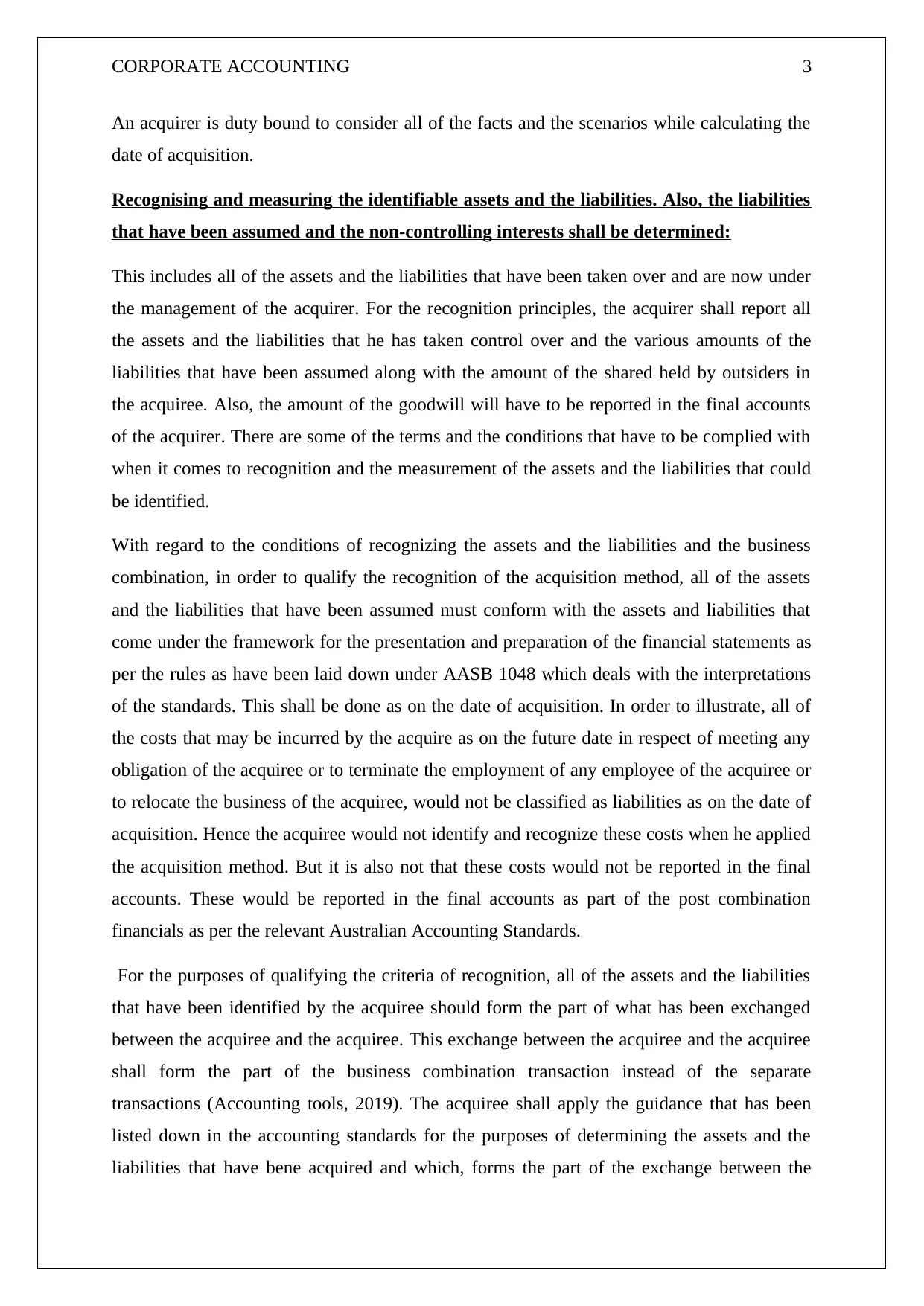
CORPORATE ACCOUNTING 3
An acquirer is duty bound to consider all of the facts and the scenarios while calculating the
date of acquisition.
Recognising and measuring the identifiable assets and the liabilities. Also, the liabilities
that have been assumed and the non-controlling interests shall be determined:
This includes all of the assets and the liabilities that have been taken over and are now under
the management of the acquirer. For the recognition principles, the acquirer shall report all
the assets and the liabilities that he has taken control over and the various amounts of the
liabilities that have been assumed along with the amount of the shared held by outsiders in
the acquiree. Also, the amount of the goodwill will have to be reported in the final accounts
of the acquirer. There are some of the terms and the conditions that have to be complied with
when it comes to recognition and the measurement of the assets and the liabilities that could
be identified.
With regard to the conditions of recognizing the assets and the liabilities and the business
combination, in order to qualify the recognition of the acquisition method, all of the assets
and the liabilities that have been assumed must conform with the assets and liabilities that
come under the framework for the presentation and preparation of the financial statements as
per the rules as have been laid down under AASB 1048 which deals with the interpretations
of the standards. This shall be done as on the date of acquisition. In order to illustrate, all of
the costs that may be incurred by the acquire as on the future date in respect of meeting any
obligation of the acquiree or to terminate the employment of any employee of the acquiree or
to relocate the business of the acquiree, would not be classified as liabilities as on the date of
acquisition. Hence the acquiree would not identify and recognize these costs when he applied
the acquisition method. But it is also not that these costs would not be reported in the final
accounts. These would be reported in the final accounts as part of the post combination
financials as per the relevant Australian Accounting Standards.
For the purposes of qualifying the criteria of recognition, all of the assets and the liabilities
that have been identified by the acquiree should form the part of what has been exchanged
between the acquiree and the acquiree. This exchange between the acquiree and the acquiree
shall form the part of the business combination transaction instead of the separate
transactions (Accounting tools, 2019). The acquiree shall apply the guidance that has been
listed down in the accounting standards for the purposes of determining the assets and the
liabilities that have bene acquired and which, forms the part of the exchange between the
An acquirer is duty bound to consider all of the facts and the scenarios while calculating the
date of acquisition.
Recognising and measuring the identifiable assets and the liabilities. Also, the liabilities
that have been assumed and the non-controlling interests shall be determined:
This includes all of the assets and the liabilities that have been taken over and are now under
the management of the acquirer. For the recognition principles, the acquirer shall report all
the assets and the liabilities that he has taken control over and the various amounts of the
liabilities that have been assumed along with the amount of the shared held by outsiders in
the acquiree. Also, the amount of the goodwill will have to be reported in the final accounts
of the acquirer. There are some of the terms and the conditions that have to be complied with
when it comes to recognition and the measurement of the assets and the liabilities that could
be identified.
With regard to the conditions of recognizing the assets and the liabilities and the business
combination, in order to qualify the recognition of the acquisition method, all of the assets
and the liabilities that have been assumed must conform with the assets and liabilities that
come under the framework for the presentation and preparation of the financial statements as
per the rules as have been laid down under AASB 1048 which deals with the interpretations
of the standards. This shall be done as on the date of acquisition. In order to illustrate, all of
the costs that may be incurred by the acquire as on the future date in respect of meeting any
obligation of the acquiree or to terminate the employment of any employee of the acquiree or
to relocate the business of the acquiree, would not be classified as liabilities as on the date of
acquisition. Hence the acquiree would not identify and recognize these costs when he applied
the acquisition method. But it is also not that these costs would not be reported in the final
accounts. These would be reported in the final accounts as part of the post combination
financials as per the relevant Australian Accounting Standards.
For the purposes of qualifying the criteria of recognition, all of the assets and the liabilities
that have been identified by the acquiree should form the part of what has been exchanged
between the acquiree and the acquiree. This exchange between the acquiree and the acquiree
shall form the part of the business combination transaction instead of the separate
transactions (Accounting tools, 2019). The acquiree shall apply the guidance that has been
listed down in the accounting standards for the purposes of determining the assets and the
liabilities that have bene acquired and which, forms the part of the exchange between the
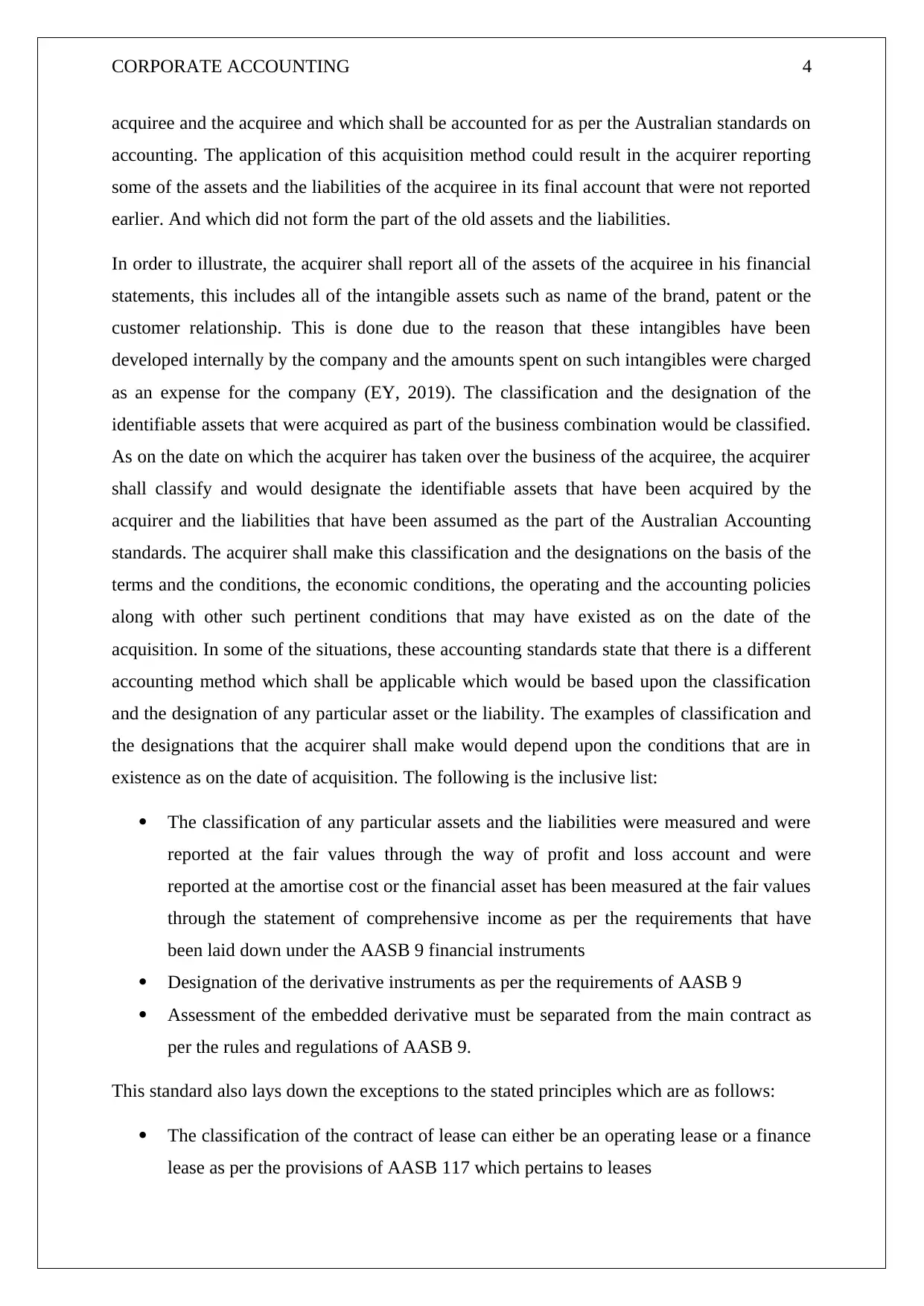
CORPORATE ACCOUNTING 4
acquiree and the acquiree and which shall be accounted for as per the Australian standards on
accounting. The application of this acquisition method could result in the acquirer reporting
some of the assets and the liabilities of the acquiree in its final account that were not reported
earlier. And which did not form the part of the old assets and the liabilities.
In order to illustrate, the acquirer shall report all of the assets of the acquiree in his financial
statements, this includes all of the intangible assets such as name of the brand, patent or the
customer relationship. This is done due to the reason that these intangibles have been
developed internally by the company and the amounts spent on such intangibles were charged
as an expense for the company (EY, 2019). The classification and the designation of the
identifiable assets that were acquired as part of the business combination would be classified.
As on the date on which the acquirer has taken over the business of the acquiree, the acquirer
shall classify and would designate the identifiable assets that have been acquired by the
acquirer and the liabilities that have been assumed as the part of the Australian Accounting
standards. The acquirer shall make this classification and the designations on the basis of the
terms and the conditions, the economic conditions, the operating and the accounting policies
along with other such pertinent conditions that may have existed as on the date of the
acquisition. In some of the situations, these accounting standards state that there is a different
accounting method which shall be applicable which would be based upon the classification
and the designation of any particular asset or the liability. The examples of classification and
the designations that the acquirer shall make would depend upon the conditions that are in
existence as on the date of acquisition. The following is the inclusive list:
The classification of any particular assets and the liabilities were measured and were
reported at the fair values through the way of profit and loss account and were
reported at the amortise cost or the financial asset has been measured at the fair values
through the statement of comprehensive income as per the requirements that have
been laid down under the AASB 9 financial instruments
Designation of the derivative instruments as per the requirements of AASB 9
Assessment of the embedded derivative must be separated from the main contract as
per the rules and regulations of AASB 9.
This standard also lays down the exceptions to the stated principles which are as follows:
The classification of the contract of lease can either be an operating lease or a finance
lease as per the provisions of AASB 117 which pertains to leases
acquiree and the acquiree and which shall be accounted for as per the Australian standards on
accounting. The application of this acquisition method could result in the acquirer reporting
some of the assets and the liabilities of the acquiree in its final account that were not reported
earlier. And which did not form the part of the old assets and the liabilities.
In order to illustrate, the acquirer shall report all of the assets of the acquiree in his financial
statements, this includes all of the intangible assets such as name of the brand, patent or the
customer relationship. This is done due to the reason that these intangibles have been
developed internally by the company and the amounts spent on such intangibles were charged
as an expense for the company (EY, 2019). The classification and the designation of the
identifiable assets that were acquired as part of the business combination would be classified.
As on the date on which the acquirer has taken over the business of the acquiree, the acquirer
shall classify and would designate the identifiable assets that have been acquired by the
acquirer and the liabilities that have been assumed as the part of the Australian Accounting
standards. The acquirer shall make this classification and the designations on the basis of the
terms and the conditions, the economic conditions, the operating and the accounting policies
along with other such pertinent conditions that may have existed as on the date of the
acquisition. In some of the situations, these accounting standards state that there is a different
accounting method which shall be applicable which would be based upon the classification
and the designation of any particular asset or the liability. The examples of classification and
the designations that the acquirer shall make would depend upon the conditions that are in
existence as on the date of acquisition. The following is the inclusive list:
The classification of any particular assets and the liabilities were measured and were
reported at the fair values through the way of profit and loss account and were
reported at the amortise cost or the financial asset has been measured at the fair values
through the statement of comprehensive income as per the requirements that have
been laid down under the AASB 9 financial instruments
Designation of the derivative instruments as per the requirements of AASB 9
Assessment of the embedded derivative must be separated from the main contract as
per the rules and regulations of AASB 9.
This standard also lays down the exceptions to the stated principles which are as follows:
The classification of the contract of lease can either be an operating lease or a finance
lease as per the provisions of AASB 117 which pertains to leases
Secure Best Marks with AI Grader
Need help grading? Try our AI Grader for instant feedback on your assignments.
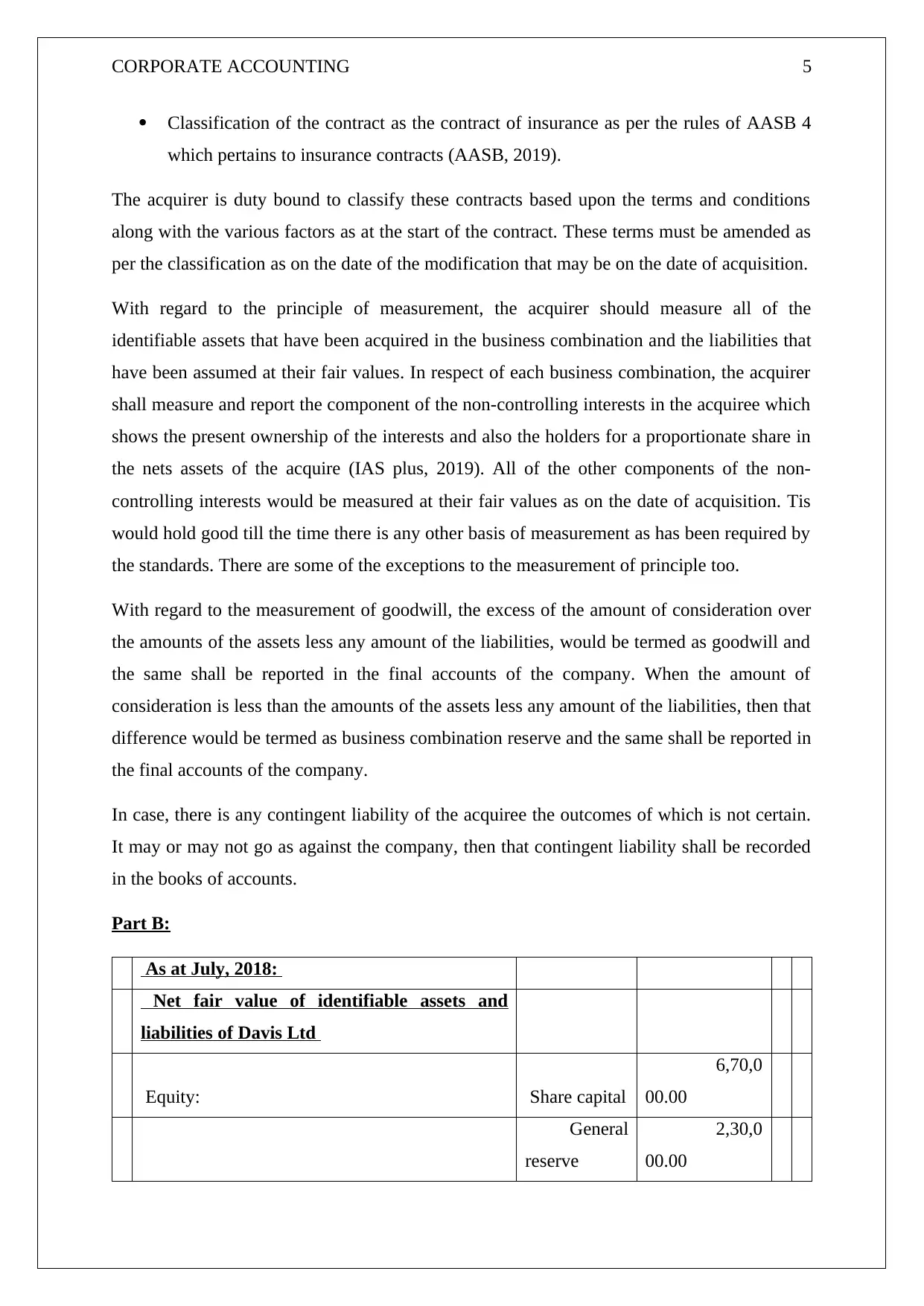
CORPORATE ACCOUNTING 5
Classification of the contract as the contract of insurance as per the rules of AASB 4
which pertains to insurance contracts (AASB, 2019).
The acquirer is duty bound to classify these contracts based upon the terms and conditions
along with the various factors as at the start of the contract. These terms must be amended as
per the classification as on the date of the modification that may be on the date of acquisition.
With regard to the principle of measurement, the acquirer should measure all of the
identifiable assets that have been acquired in the business combination and the liabilities that
have been assumed at their fair values. In respect of each business combination, the acquirer
shall measure and report the component of the non-controlling interests in the acquiree which
shows the present ownership of the interests and also the holders for a proportionate share in
the nets assets of the acquire (IAS plus, 2019). All of the other components of the non-
controlling interests would be measured at their fair values as on the date of acquisition. Tis
would hold good till the time there is any other basis of measurement as has been required by
the standards. There are some of the exceptions to the measurement of principle too.
With regard to the measurement of goodwill, the excess of the amount of consideration over
the amounts of the assets less any amount of the liabilities, would be termed as goodwill and
the same shall be reported in the final accounts of the company. When the amount of
consideration is less than the amounts of the assets less any amount of the liabilities, then that
difference would be termed as business combination reserve and the same shall be reported in
the final accounts of the company.
In case, there is any contingent liability of the acquiree the outcomes of which is not certain.
It may or may not go as against the company, then that contingent liability shall be recorded
in the books of accounts.
Part B:
As at July, 2018:
Net fair value of identifiable assets and
liabilities of Davis Ltd
Equity: Share capital
6,70,0
00.00
General
reserve
2,30,0
00.00
Classification of the contract as the contract of insurance as per the rules of AASB 4
which pertains to insurance contracts (AASB, 2019).
The acquirer is duty bound to classify these contracts based upon the terms and conditions
along with the various factors as at the start of the contract. These terms must be amended as
per the classification as on the date of the modification that may be on the date of acquisition.
With regard to the principle of measurement, the acquirer should measure all of the
identifiable assets that have been acquired in the business combination and the liabilities that
have been assumed at their fair values. In respect of each business combination, the acquirer
shall measure and report the component of the non-controlling interests in the acquiree which
shows the present ownership of the interests and also the holders for a proportionate share in
the nets assets of the acquire (IAS plus, 2019). All of the other components of the non-
controlling interests would be measured at their fair values as on the date of acquisition. Tis
would hold good till the time there is any other basis of measurement as has been required by
the standards. There are some of the exceptions to the measurement of principle too.
With regard to the measurement of goodwill, the excess of the amount of consideration over
the amounts of the assets less any amount of the liabilities, would be termed as goodwill and
the same shall be reported in the final accounts of the company. When the amount of
consideration is less than the amounts of the assets less any amount of the liabilities, then that
difference would be termed as business combination reserve and the same shall be reported in
the final accounts of the company.
In case, there is any contingent liability of the acquiree the outcomes of which is not certain.
It may or may not go as against the company, then that contingent liability shall be recorded
in the books of accounts.
Part B:
As at July, 2018:
Net fair value of identifiable assets and
liabilities of Davis Ltd
Equity: Share capital
6,70,0
00.00
General
reserve
2,30,0
00.00
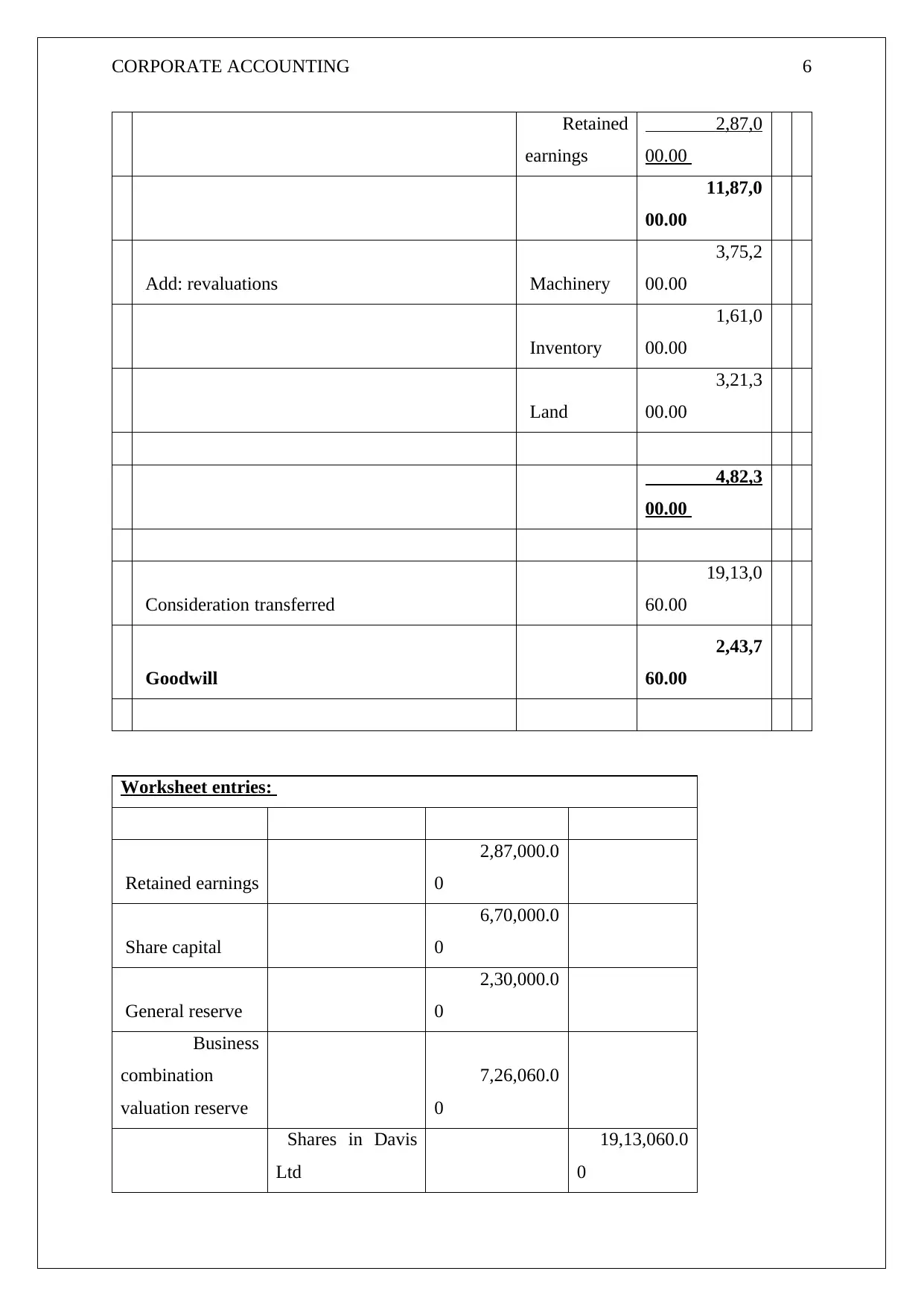
CORPORATE ACCOUNTING 6
Retained
earnings
2,87,0
00.00
11,87,0
00.00
Add: revaluations Machinery
3,75,2
00.00
Inventory
1,61,0
00.00
Land
3,21,3
00.00
4,82,3
00.00
Consideration transferred
19,13,0
60.00
Goodwill
2,43,7
60.00
Worksheet entries:
Retained earnings
2,87,000.0
0
Share capital
6,70,000.0
0
General reserve
2,30,000.0
0
Business
combination
valuation reserve
7,26,060.0
0
Shares in Davis
Ltd
19,13,060.0
0
Retained
earnings
2,87,0
00.00
11,87,0
00.00
Add: revaluations Machinery
3,75,2
00.00
Inventory
1,61,0
00.00
Land
3,21,3
00.00
4,82,3
00.00
Consideration transferred
19,13,0
60.00
Goodwill
2,43,7
60.00
Worksheet entries:
Retained earnings
2,87,000.0
0
Share capital
6,70,000.0
0
General reserve
2,30,000.0
0
Business
combination
valuation reserve
7,26,060.0
0
Shares in Davis
Ltd
19,13,060.0
0
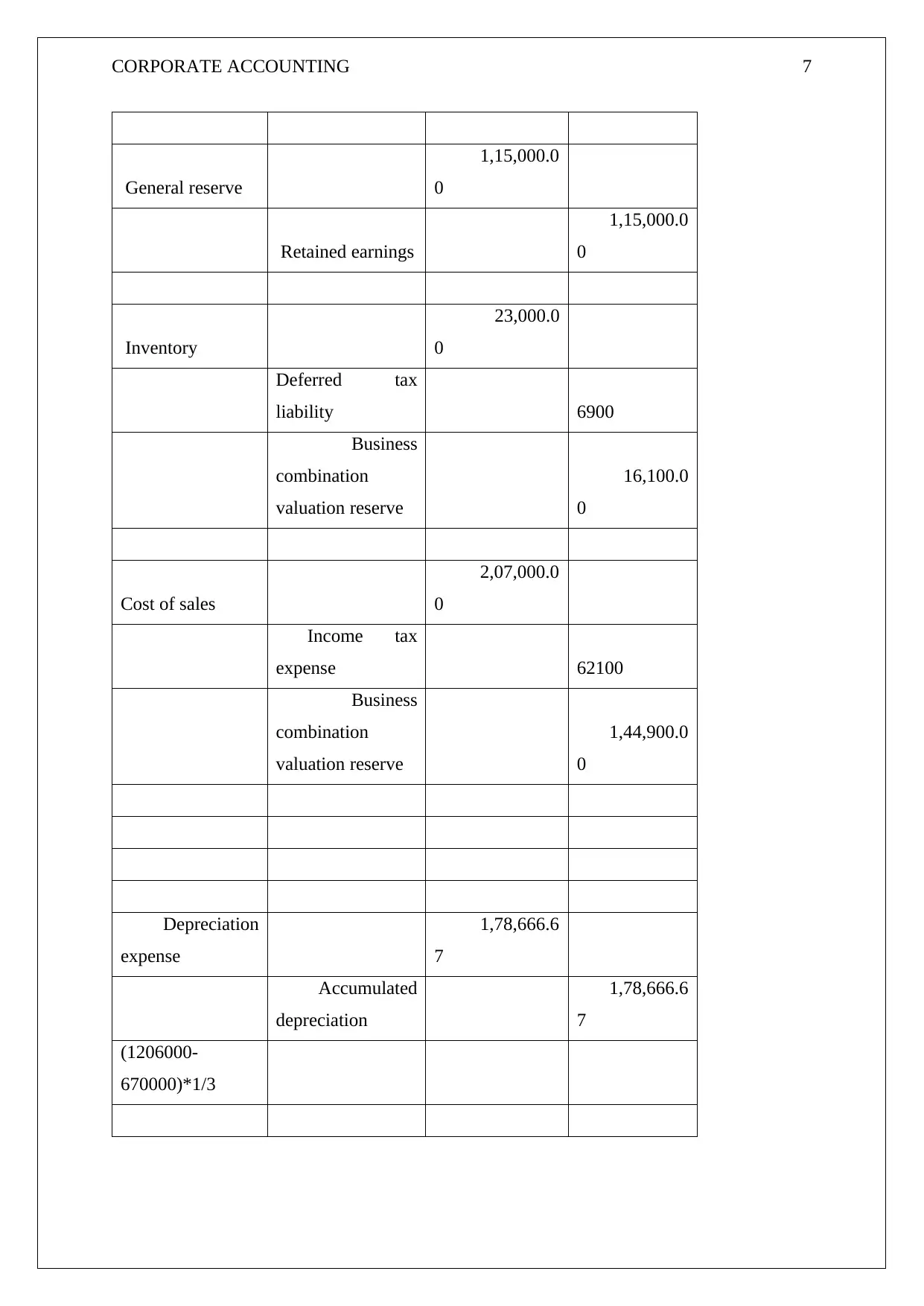
CORPORATE ACCOUNTING 7
General reserve
1,15,000.0
0
Retained earnings
1,15,000.0
0
Inventory
23,000.0
0
Deferred tax
liability 6900
Business
combination
valuation reserve
16,100.0
0
Cost of sales
2,07,000.0
0
Income tax
expense 62100
Business
combination
valuation reserve
1,44,900.0
0
Depreciation
expense
1,78,666.6
7
Accumulated
depreciation
1,78,666.6
7
(1206000-
670000)*1/3
General reserve
1,15,000.0
0
Retained earnings
1,15,000.0
0
Inventory
23,000.0
0
Deferred tax
liability 6900
Business
combination
valuation reserve
16,100.0
0
Cost of sales
2,07,000.0
0
Income tax
expense 62100
Business
combination
valuation reserve
1,44,900.0
0
Depreciation
expense
1,78,666.6
7
Accumulated
depreciation
1,78,666.6
7
(1206000-
670000)*1/3
Paraphrase This Document
Need a fresh take? Get an instant paraphrase of this document with our AI Paraphraser
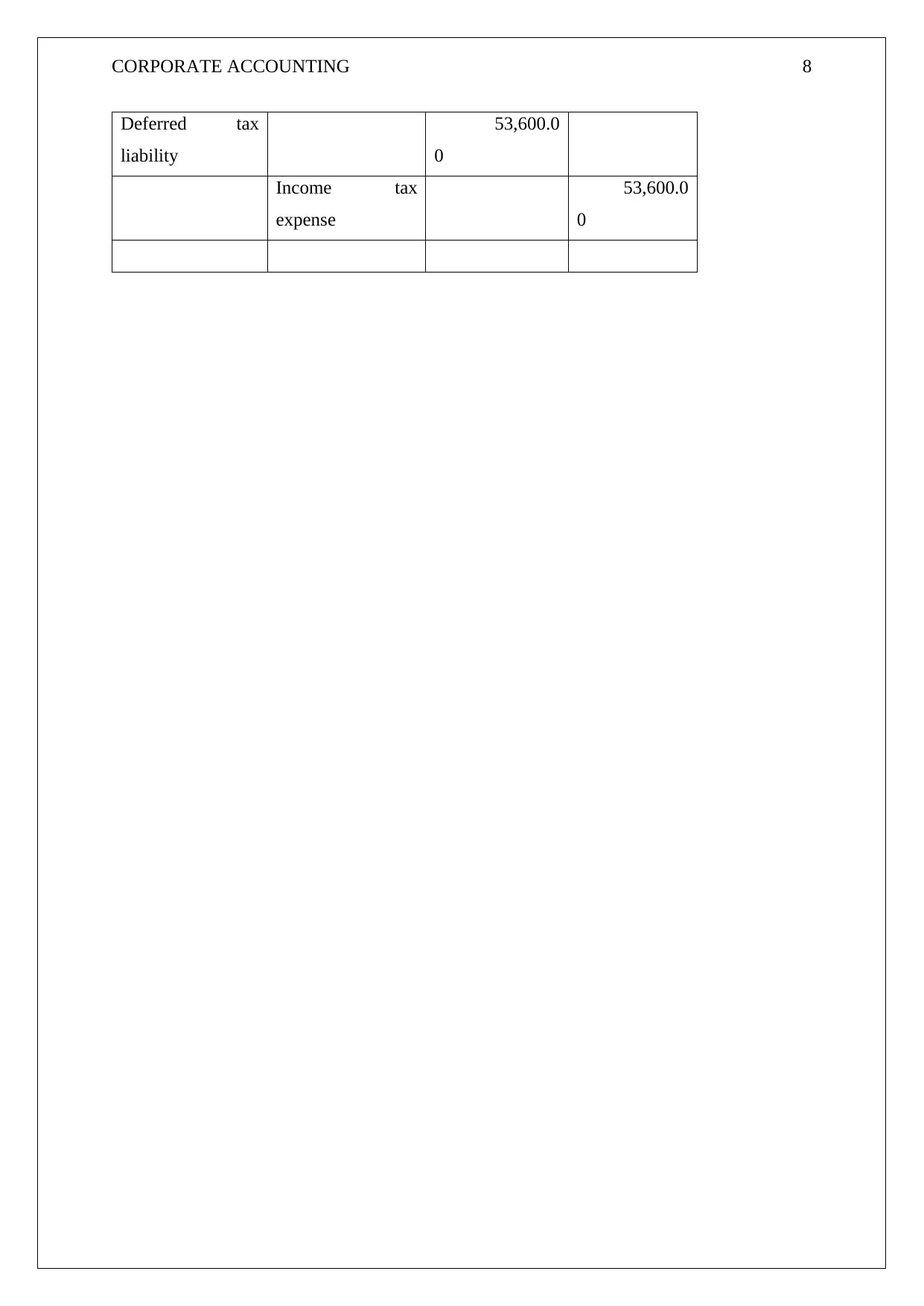
CORPORATE ACCOUNTING 8
Deferred tax
liability
53,600.0
0
Income tax
expense
53,600.0
0
Deferred tax
liability
53,600.0
0
Income tax
expense
53,600.0
0
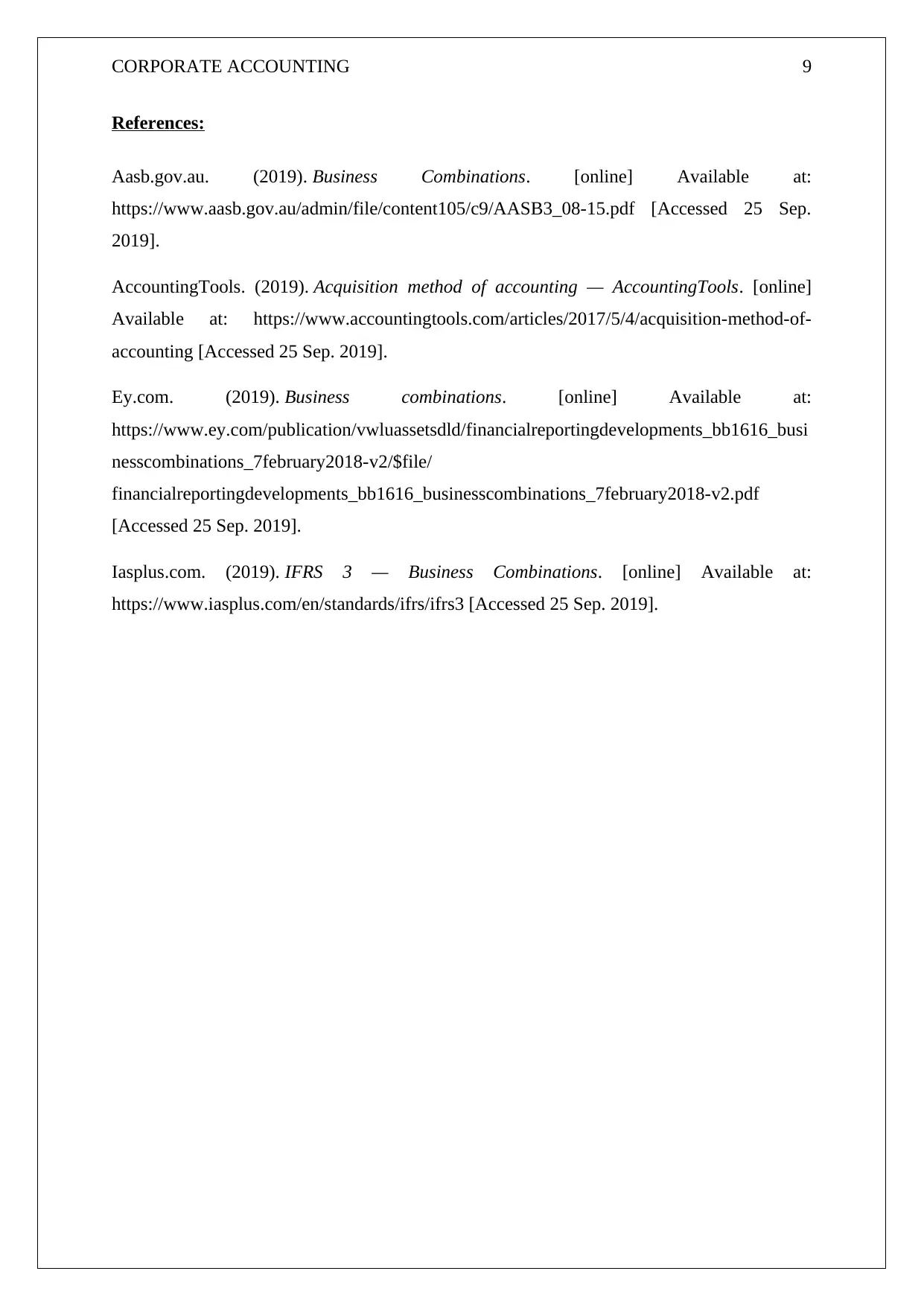
CORPORATE ACCOUNTING 9
References:
Aasb.gov.au. (2019). Business Combinations. [online] Available at:
https://www.aasb.gov.au/admin/file/content105/c9/AASB3_08-15.pdf [Accessed 25 Sep.
2019].
AccountingTools. (2019). Acquisition method of accounting — AccountingTools. [online]
Available at: https://www.accountingtools.com/articles/2017/5/4/acquisition-method-of-
accounting [Accessed 25 Sep. 2019].
Ey.com. (2019). Business combinations. [online] Available at:
https://www.ey.com/publication/vwluassetsdld/financialreportingdevelopments_bb1616_busi
nesscombinations_7february2018-v2/$file/
financialreportingdevelopments_bb1616_businesscombinations_7february2018-v2.pdf
[Accessed 25 Sep. 2019].
Iasplus.com. (2019). IFRS 3 — Business Combinations. [online] Available at:
https://www.iasplus.com/en/standards/ifrs/ifrs3 [Accessed 25 Sep. 2019].
References:
Aasb.gov.au. (2019). Business Combinations. [online] Available at:
https://www.aasb.gov.au/admin/file/content105/c9/AASB3_08-15.pdf [Accessed 25 Sep.
2019].
AccountingTools. (2019). Acquisition method of accounting — AccountingTools. [online]
Available at: https://www.accountingtools.com/articles/2017/5/4/acquisition-method-of-
accounting [Accessed 25 Sep. 2019].
Ey.com. (2019). Business combinations. [online] Available at:
https://www.ey.com/publication/vwluassetsdld/financialreportingdevelopments_bb1616_busi
nesscombinations_7february2018-v2/$file/
financialreportingdevelopments_bb1616_businesscombinations_7february2018-v2.pdf
[Accessed 25 Sep. 2019].
Iasplus.com. (2019). IFRS 3 — Business Combinations. [online] Available at:
https://www.iasplus.com/en/standards/ifrs/ifrs3 [Accessed 25 Sep. 2019].
1 out of 9
Related Documents
Your All-in-One AI-Powered Toolkit for Academic Success.
+13062052269
info@desklib.com
Available 24*7 on WhatsApp / Email
![[object Object]](/_next/static/media/star-bottom.7253800d.svg)
Unlock your academic potential
© 2024 | Zucol Services PVT LTD | All rights reserved.




